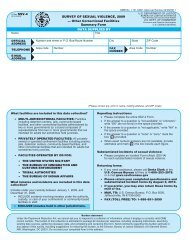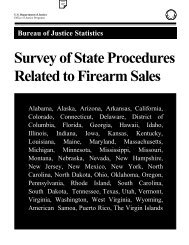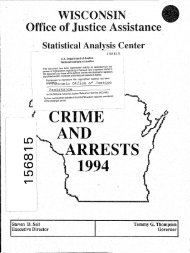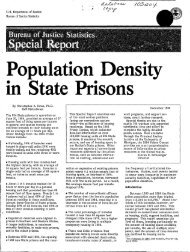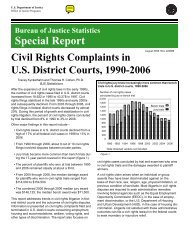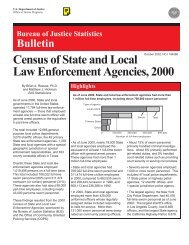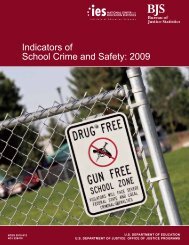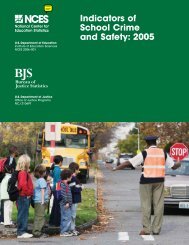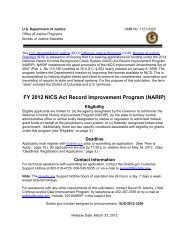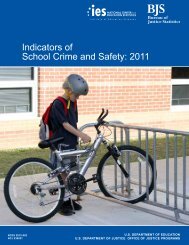AppendicesJlPPENDIX 12Table 2 Distribution <strong>of</strong> reports across jurisdictions that submitted case data(N=420,216)National Analysis <strong>of</strong> Official Child Neglect and Abuse Reporting-Study methodologyAbuse/Abuse Neglect neglect Olher a TotalNJTE: The following information was provided to SOURCEBOOK staff by the American HumaneAssociation.The National Study on Child Neglect and Abuse Reporting is aproject conducted by the American Humane Association and funded bythe National Center on Child Abuse and Neglect <strong>of</strong> the U.S. Department<strong>of</strong> Health and Human Services. It began as a grant awarded to theAmerican Humane Association in 1973 to determine the feasibility <strong>of</strong>operating a national clearinghouse for child abuse and neglect reportsin order to be able to describe the national status <strong>of</strong> the childmaltreatment problem. In 1976, detailed analyses <strong>of</strong> the data werefirst available. In 1978, the American Humane Association, inconjunction with the Denver Research Institute, was awarded acontract to continue the work <strong>of</strong> the clearinghouse, to more carefullydefine the data set, and to provide training and technical assistance toStates.The rosie objectives <strong>of</strong> the clearinghouse function <strong>of</strong> the NationalStudy are as follows: (I) determine the number <strong>of</strong> families, allegedperpetrators, and involved children on <strong>of</strong>ficial reports <strong>of</strong> childmaltreatment; (2) determine the source <strong>of</strong> referral and the geographicdistribution <strong>of</strong> <strong>of</strong>ficial reports; (3) describe the characteristics <strong>of</strong>families, peroetrators, and children involved in <strong>of</strong>ficial reports and,where possible, compare then against the general population; (4)describe the response <strong>of</strong> the child protective services system to thereport; and (5) identify and describe trends in the reporting dataacross and within jurisdictions.Procedures for data collection and analysisThe data collected by the National Study are basically <strong>of</strong> twotypes: summary data, used to describe the extent <strong>of</strong> reportedmaltreatment on a national basis; and case information, used todescribe the dynamics <strong>of</strong> reporting and also the nature <strong>of</strong> what wasreported. Jurisdictions that submit case data do so voluntarily. Most<strong>of</strong>ten, participation in the National Study is integrated into thejurisdiction's child protective services management information system.During 1982, all 50 States, the District <strong>of</strong> Columbia, and threeU.S. Territories participated in the National Study to some degree.The 37 fully participating jurisdictions submitted case data by means <strong>of</strong>either nonidentifying copies <strong>of</strong> <strong>of</strong>ficial reparting forms or a data tapethat contained reporting data organized by case (Level I). Theremaining jurisdictions submitted sumnary statistics to the NationalStudy (Level 2). Table I shows the distribution <strong>of</strong> participation ateach level.Prior to inclusion, each record must meet certain minimumcriteria for completeness and must successfully pass a series <strong>of</strong> editspecifications to insure the integrity <strong>of</strong> the data base. Forms that failediting at any point are either corrected by the National Study staff orare returned to the originating participant jurisdiction for correctionand resubmittal.Potentially any jurisdictional reporting form is appropriate forcollection <strong>of</strong> National Study data. However, only those data items thatare compatible with the National Study's masterfile can be used.Jurisdictions can and do vary in terms <strong>of</strong> how milch <strong>of</strong> their data canbe actually included in the data base.Data compatability is determined through a mapping process,which essentially entails verifying with the jurisdiction that thepurpose and meaning <strong>of</strong> a particular data element on their form is thesame as that <strong>of</strong> a corresponding National Study data element. Hence,the total number <strong>of</strong> reports used in each data table varies. This is afunction <strong>of</strong> two types <strong>of</strong> data completeness: the actual number <strong>of</strong>campatible data elements and the combination <strong>of</strong> compatible dataelements that constitute a data category.Fully participatingAlaskaArizonaArkansasColoradoDelawareDistrict <strong>of</strong>ColumbiaFloridaGeorgiaHawaiiIllinoisIndianaIowaKentuckyLouisianaMaineMichiganMinnesotaMississippiTableLevelMissouriNebraskaNevadaNew HompshireNew MexicoNew YorkNarth CarolinaNcnh DakotaOhioPennsylvaniaRhode IslandSouth CarolinaTexasUtahVermontVirginiaWisconsinGuamVirgin IslandsLevel 2Summary statisticsAlabamaCaliforniaConnecti cutIdahoKansasMarylandMassachusettsMontanaNew Jer5eyOklahomaOregonPuerto RicoSouth DakotaTennesseeWashingtonWest VirginiaWyomingTable 2 shows the distribution <strong>of</strong> reports across jurisdictions thatsubmitted case data. These reports constituted the data bank used inthe analyses <strong>of</strong> case information. It is important to remind the reader,however, that although the majority <strong>of</strong> reports represent the same set<strong>of</strong> data elements, some do not. In addition, there was variation in thecompleteness <strong>of</strong> each report's data set. For these reasons, all <strong>of</strong> thereports in the !'lational Study data base were not always used to derivea given statistical summary. The "N" fer each data table varies as afunction <strong>of</strong> data element compatibility and data set completeness.Interpretation <strong>of</strong> the dataReporting on a national level has increased by 106 percent since1976. This can be attributed to a number <strong>of</strong> factors. First, it must bepointed out that it may be impossible to determine if an increase inreporting is directly related to an increase in the number <strong>of</strong> childrenwho are maltreated. The main reason for this is that there is nonationally standardized definition <strong>of</strong> maltreatment. Further, individualjurisdictions continue to modify reporting legislation to encompass newreportable conditions, e.g., emotional maltreatment. Reporting"measures" different phenomena in each jurisdiction and, in addition,what is measured in each jUrisdiction may change each year.Compounding this situation is that it is known that not all occurrences<strong>of</strong> maltreatment are reported. It is likely that the increase inreporting is due to improved accountability on the port <strong>of</strong> jurisdictionalsystems.In addition to reflecting broadened reportable conditions andimproved accountability, the increase in reporting also reflectsincreased public awareness <strong>of</strong> the child maltreatment problem, and acorresponding increase in willingness to report.It is interesting to note, however, that the magnitude <strong>of</strong> theincrease from one year to another has been steadily decreasing withtime. It is unlikely that this means that reported incidence isapproaching actual incidence for the reasons mentioned above. Rather,it probably reflects a steady approach to the limit in terms <strong>of</strong> whatchild protective services can handle.!i1\IiiIIILJII!I" I'hIiii"Alaska 0 0 0 2,649 2,649Arizona 1,452 1,530 148 4,58U 7,710Afkansas 3,073 4,607 1,074 0 8,754Colorado 0 0 0 5,446 5,446Delaware 450 698 190 928 2,266District <strong>of</strong> Columbia 0 0 0 1,878 1,878Florida 0 0 0 46,035 46,035Georgia 2,885 5,685 833 5,051 14,454Howaii 1,075 437 157 14 1,683Illinois 10,845 14,383 6,784 II 32,023Indiana 5,570 6,061 4 119 11,754Iowa 0 0 0 14,062 14,062Kentucky 3,110 4,589 0 80 7,779Louisiana 2,911 6,648 1,346 189 11,094Maine 778 1,141 851 II 2,781Michigan 4,341 8,527 298 19,153 32,319Minnesota 4,050 2,765 968 9 7,791Mississippi 0 0 0 2,813 2,813Missouri 4,181 9,858 819 13,574 28,432Nebraska 0 0 0 1,497 1,497Nevada 1,023 1,878 292 78 3,271New Hampshire 0 0 0 2,136 2,163New Mexico 1,225 1,937 384 32 3,57!lNew York 2,596 13,878 27,200 8,132 51,806Narth Carolina 0 0 0 15,830 15,830North Dakota 454 849 226 20 1,549Ohio 6,252 7,345 1,823 1,094 16,514Pennsylvania 0 0 0 13,653 13,6$:~Rhode Island 380 272 98 59 ;:'l!l"South Carolina 3,S02 7,162 728 298 II ,~~(jTexas 0 0 0 29,660 29,660Ulah 0 0 0 4,651 4,651Vermont 385 411 455 2 1,253Virginia 0 0 0 14,253 14,253Wisconsin 3,514 2,453 317 15 6,299Guam 2 3 I 0 6Virgin Islands 19 8 10 I 38Total 64,073 103,124 45,006 208,013 420,216a"Other" incudes all <strong>of</strong> those reports not clearly labelled as either "abuse""neglect," or "abuse/neglect," or those for which "type <strong>of</strong> repart" was missing ~rincompatible with National Study criteria.~659658
------------ - -APPENDIX 14APPENDIX 13Discipline, Order and Student Behavior in American High Schools-Survey methodology and definitions <strong>of</strong> terms!\oTE: The following information was excerpted from U.S. Deportment <strong>of</strong> Education, Notional Centerfor Education <strong>Statistics</strong>, Discipline, Order and Student Behavior in American High Schools(Washington, D.C.: U.S. Government Printing Office, 1982), pp. xiii-xiv, II, 12, Appendix A.The data and analyses presented in this report are from the first(1980) wove <strong>of</strong> the Notional Center for Education <strong>Statistics</strong> study, HighSchool and Beyond, a longitudinal study <strong>of</strong> U.S. high school seniors andsophomores. This study was conducted for the Notional Center forEducation <strong>Statistics</strong> by the Notional Opinion Research Center at theUniversity <strong>of</strong> Chicago.Survey methodologyThe sample was a two-stage stratified probability sample withschools within a stratum drown with a probability proportional to theirsize. Once a school was selected, up to 36 sophomores and 36 seniorswere drawn randomly from the students enrolled in each selectedschool.Several special strata were included in the sample design.Schools in these special strata were selected with probabilities higherthan those for schools in regular strata to allow for special study <strong>of</strong>certain types <strong>of</strong> schools or students. The following kinds <strong>of</strong> schoolswere oversampled: public schools with high proportions <strong>of</strong> Hispanic(Cuban, Puerto Rican, and Mexican) students; Catholic schools withhigh proportions <strong>of</strong> minority group students; public alfernative schools;private schools with high proportions <strong>of</strong> Notional Merit Scholarshipfinalists. Substitutions were mode for noncooperating schools in thosestrata where it was possible. Out <strong>of</strong> 1,122 possible schools, students at1,015 schools and school administrators from 988 schools filled outquestionnaires.In many schools the actual number <strong>of</strong> seniors and sophomores wasless than the target number for several reasons. First, in some schoolsfewer than 36 sophomores or 36 seniors were enrolled. This reducedthe number <strong>of</strong> eligible students from 73,O!J0 (72 students in each <strong>of</strong>1,015 schools) to 70,704. Second, 8,278 students were absent on thesurvey dote. Third, 1,982 students, or in some cases their parents,declined to po,ticipate, exercising their right in a voluntary survey.Substi tutions were not mode for noncooperating students. Finally,2,174 cases were deleted because they contained only very incampleteinformation. Thus, the main student sample consists <strong>of</strong> 30,030sophomores and 28,240 seniors. This represents a completion rate <strong>of</strong> 82percent: 58,270 out <strong>of</strong> the 70,704 eligible students. This report, likeothers in this series, is based on a slightly larger number (30,263sophomores and 2!J,465 seniors), since the twins <strong>of</strong> some sampledstudents were included in the original data files.Weights were calculated to reflect differential probabilities <strong>of</strong>sample selection and to adjust for non-response. Using appropriateweights yields estimotes for high school sophomores and seniors in theUnited Sta.~s and separate estimotes for schools or students classifiedin various ways, such as by geographical region or school type.The use <strong>of</strong> weighted frequencies in the computation <strong>of</strong> the tables<strong>of</strong> the report has implications for the interpretation <strong>of</strong> table entries.660Weighted and unweighted frequencies cannot be used interchangeably.Thus, for exarns on the nonmedical use <strong>of</strong> psychotherapeutics. These formsWeTe filled out by the respondent while the interviewer read thequestions aloud. On certain later answer sheets, interviewers usedtheir judgment on whether or not to <strong>of</strong>fer respondents the option <strong>of</strong>reading silently and filling the sheets out entirely on their own.Definitions <strong>of</strong> termsAlcohol-1982: beer, _wine, and liquor, like whiskey or gin. 1979:beer, wine, and whiskey, gin, other hard liquors. 1977, 1976, and 1974:beer, wine, whiskey, or anything else to drink with alcohol in it. 1972:beer, wine, hard liquor like cocktails or highballs, or on the rocks, orstraight shots. Note: the responses to the 1979 and 1982 alcoholquestions were marked on a private answer sheet rather than beingspoken to the interviewer as in 1977, 1976, 1974, and 1972.Analgesics-1982: painkilling pills thaI are usually avaiiable onlywith a Q9ct9r's prescription. 19791 pills ysed megjcqlly to relieve pain.Analgesics are divided into four subgroups: propoxyphene, otheranalgesics, methadone, and agonist/antagonist. Note. see definition for"Nonmedical experience with psychotherapeutic drugs."Current drinker-1982, 1979, 1977, 1'i76, and 1974: drank in postmonth. 1972: drank in post 7 days. Note: the response to the 1982and 1979 alcohol questions were marked on a private answer sheetrather than being spoken to the interviewer as in 1977, 1976, 1974 and1972.Current srnoker-1982, 1977, 1976, and 1974: smoked within postmonth. 1')79: smoked in past 30 days, and has smoked as many as fivepocks <strong>of</strong> cigarettes during lifetime. 1971 and 1971: smoke at the"present time."Current user <strong>of</strong> drugs-1979, 1977 and 1976: has used within thepast month. 1974: has used within the post month, and indicatesintention to use again. In practice, intention to use was dropped incomputation because virtually all past month users indicated intent touse again. 1972 and 1971: marihuana--self-designated current userswho report usage "once a month or less" as well as those users whoreport frequent usage; other drugs, has used within post manth.HolJucinagens-1982 and 1979. LSD and other hallucinogens suchas PCP or phencyclidine, mescaline, peyote, psilocybin, DMT. 1977and 1976: LSD and other hallucinogens like mescaline, peyote,psilocybin, and DMT. 1974: LSD or other hallucinogens. 1972: LSD orsomething like it, such as mescaline, psilocybin, MSA, STP.Inhalants-1979: I) gasoline or lighter flUid; 2) spray points; 3)other aerosol sprays (PAM or deodorants); 4) shoe shine, glUe, ortoluene; 5) lacquer thinner, or other point solvents; 6) amyl nitrate,'poppers'; 7) halothane, ether, a'· other anesthetics; 8) nitrous oxide,whippets; 9) locker room od"rizersj I 0) other substances used as
- Page 1 and 2:
u.s. Department of JusticeBureau of
- Page 3 and 4:
________ n~'·••SOURCEBOOKOF CR
- Page 5 and 6:
Sourcebook of Criminal Justice Stat
- Page 7 and 8:
Figure B An overview of detelnclude
- Page 9 and 10:
--------- - --Svurcebook of Crimina
- Page 11 and 12:
- - .. "-- - ~------~ ------------C
- Page 13 and 14:
Figure3.12 Estimated rate (per 100,
- Page 15 and 16:
TableFig. 2.6 Respondents taking pr
- Page 17 and 18:
Sourcebook of Criminal Justice Stat
- Page 19 and 20:
---------- - -- ~------------------
- Page 21 and 22:
- ...... - ~r---~---------~--------
- Page 24 and 25:
------------- - ~------~-----~-----
- Page 26 and 27:
Sourcebook of Criminal Justice Stat
- Page 28 and 29:
--------- -' -- - -'-- ----~-------
- Page 30 and 31:
---- -- --~------~ ---rl.Sourcebook
- Page 32 and 33:
~~---------- ---~----------~-------
- Page 34 and 35:
-------------- - ---~---~--------~-
- Page 36 and 37:
~~~~~~~---- - -- -Sourcebook of Cri
- Page 38 and 39:
----.... ....--.-. ~"'-.~Sourcebook
- Page 40 and 41:
(Sourcebook of Criminal Justice Sta
- Page 42 and 43:
-----~---------------------.-'-----
- Page 44 and 45:
Table 1.13 Number and rateOct. 31,
- Page 46 and 47:
~-~- ~-...--~ -- ~ ---,~-------. -.
- Page 48 and 49:
-- ..... -,-.--..-... ~~----r; __ '
- Page 50 and 51:
---..0lIl, - -~,..--- -- - - ----~-
- Page 52 and 53:
-----------------------------------
- Page 54 and 55:
.~------~--------------------------
- Page 56 and 57:
"Sourcebook of Criminal Justice Sta
- Page 58 and 59:
------------ - -- -"\I'Sourcebook o
- Page 60 and 61:
Sourcebook of Criminal Justice Stat
- Page 62 and 63:
Sourcebook of Criminal Justice Stat
- Page 65 and 66:
---- ~------~--~- -..---Sourcebook
- Page 67 and 68:
Sourcebook of Criminal Justice Stat
- Page 69 and 70:
.~f'ISourcebook of Criminal Justice
- Page 71 and 72:
Characteristics of the Criminal Jus
- Page 73 and 74:
f'Sourcebook of Criminal Justice St
- Page 75 and 76:
--'~--~---------------_..."'.".,..,
- Page 77 and 78:
'Sourcebook of Criminal Justice Sta
- Page 79 and 80:
------ ~---~-----~-----~Sourcebook
- Page 81 and 82:
-----------~-~---~-------Sourcebook
- Page 83 and 84:
-----~---~~~. -'""".-=-./}Character
- Page 85 and 86:
--------------------Sourcebook of C
- Page 87 and 88:
-----------------------------------
- Page 89 and 90:
[!r-·ISourcebook of Criminal Justi
- Page 91 and 92:
- _. - -------~--...;--~"-"----- --
- Page 93 and 94:
.~. ---..ot--~.....--- -- ~------_.
- Page 95 and 96:
Sourcebook of Criminal Justice Stat
- Page 97 and 98:
--""'1,- ~,.--- --_'M~II!tlT'-~'r.
- Page 99 and 100:
- -~--~--~-~~-------~----------Tabl
- Page 101 and 102:
~~--~~--~-----~ ----Sourcebook of C
- Page 103 and 104:
~-~-------------------------_--____
- Page 105 and 106:
------------Sourcebook of Criminal
- Page 107 and 108:
Sourcebook of Criminal Justice Stat
- Page 109 and 110:
Characteristics of the Criminal Jus
- Page 111 and 112:
------- -- - -- -Sourcebook of Crim
- Page 113 and 114:
"Sourcebook of Criminal Justice Sta
- Page 115 and 116:
Sourcebook of Criminal Justice Stat
- Page 117 and 118:
------"'--~ ,'~- =--Sourcebook of C
- Page 119 and 120:
Sourcebook of Criminal Justice S;at
- Page 121 and 122:
,,iSourcebook of Criminal Justice S
- Page 123 and 124:
Source: George H. Gallup, The Gallu
- Page 125 and 126:
----~------~~--~----------~--------
- Page 127 and 128:
Sourcebook of Criminal Justice Stat
- Page 129 and 130:
--------------Sourcebook of Crimina
- Page 131 and 132:
--~-~~~~---------'---Public Attitud
- Page 133 and 134:
---------------------Sourcebook of
- Page 135 and 136:
-----------------------------------
- Page 137 and 138:
----------- --~-_.------~---t]Sourc
- Page 139 and 140:
Sourcebook of Criminal Justice Stat
- Page 141 and 142:
234Sourcebook of Criminal Justice S
- Page 143 and 144:
Sourcebook of Criminal Justice Stat
- Page 145 and 146:
~---.-.-.~~~ .. ~.Sourcebook of Cri
- Page 147 and 148:
,~--------~---------------~--------
- Page 149 and 150:
-~---------i': 1r\ jI~1 Public Atti
- Page 151 and 152:
--~---------------~----------Source
- Page 153 and 154:
~-~ - -'--~-------~----~~----------
- Page 155 and 156:
~-~- ~-----------------------------
- Page 157 and 158:
· -.Figure 2.14 Attitudes toward t
- Page 159 and 160:
Sourcebook of Criminal Justice Stat
- Page 161 and 162:
Sourcebook of Criminal Justice Stat
- Page 163 and 164:
--"'" - -~--..--- -Sourcebook of Cr
- Page 166 and 167:
.,.----------- - --" ,,jSourcebook
- Page 168 and 169:
~---~----~---" '--Sourcebook of Cri
- Page 170 and 171:
Sourcebook of Criminal Justice Stat
- Page 172 and 173:
....... ,-"'-~--... ~.Sourcebook of
- Page 174 and 175:
-- ..... --~.....-- -- -~ --'\,j--S
- Page 176 and 177:
"~Sourcebook of Criminal Justice St
- Page 178 and 179:
--~----- --~-----r\ I,I.-------. "
- Page 180 and 181:
---------------------,-------------
- Page 182 and 183:
Sourcebook of Criminal Justice Stat
- Page 184 and 185:
--------------------_.;e __ ... , .
- Page 186 and 187:
-----_.----------------------------
- Page 188 and 189:
--~--~-...---Sourcebook of Criminal
- Page 190 and 191:
----....--,-"..__._-..- ~ -- ~~ ...
- Page 192 and 193:
-- ..... -~-..---=4'CI)("")CI)9:::s
- Page 194 and 195:
-~-~ -----------------Sourcebook of
- Page 196 and 197:
Nature and Distribution of Known Of
- Page 198 and 199:
--------.-~ '-'=~~-------- -- -I1Na
- Page 200 and 201:
Nature and Distribution of Known Of
- Page 202 and 203:
---------~----------------~--------
- Page 204 and 205:
-------'''*'''_''' __ ,~=IW".(ISour
- Page 206 and 207:
;1INoture ond Distribution of /
- Page 208 and 209:
~~~-~----- ---- -~---~---~--~~-----
- Page 210 and 211:
Sourcebook of Criminol Justice Stat
- Page 212 and 213:
~ ---~ ---------- - ---Sout!:eboci<
- Page 214 and 215:
- ~--J."'~~~"_~ ..~F'"-_ ....Source
- Page 216 and 217:
Nature and Distribution of Known Of
- Page 218 and 219:
--------"Source bo 0 k of Crimi no
- Page 220 and 221:
Sourcebook of Criminol Justice Stat
- Page 222 and 223:
"---- ~ -------~~ -----------------
- Page 224 and 225:
.------~~- --~Sourcebook of Crimina
- Page 226 and 227:
396----------- -- ~Sourcebook of Cr
- Page 228 and 229:
Sourcebook of Criminal Justice Stat
- Page 230 and 231:
--Agure 3.24 Rate (per 100 officers
- Page 232 and 233:
407-~------- ----Sourcebook of Crim
- Page 234 and 235:
------------- -- ~Sourcebook of Cri
- Page 236 and 237:
Characteristics and Distribution of
- Page 238 and 239:
---.0lIl, - ~-.,---------- . ---Sou
- Page 240 and 241:
--~----~c,Sourcebook of Criminal Ju
- Page 242 and 243:
------------ - -- ----- --------~II
- Page 244 and 245:
- ----~--~\"r--. 'I[I)1Ir ri II.~\,
- Page 246 and 247:
.~--,..., - -~ --..--- --~ ----~---
- Page 248 and 249:
-------_ .. -Sourcebook of Criminal
- Page 250 and 251:
Sourcebook of Criminal Justice Stat
- Page 252 and 253:
----.------------------------------
- Page 254 and 255:
------------ - ~"Sourcebook of Crim
- Page 256 and 257:
Sourcebook of Criminal Justice Stat
- Page 258 and 259:
-------- --------~------------rSour
- Page 260 and 261:
-~--~......--- --------------------
- Page 262:
Sourcebook of Criminal Justice Stat
- Page 265 and 266:
---~--- ----------- ---------------
- Page 267 and 268:
~--~----------~--------------------
- Page 269 and 270:
----------- _. ---~--------~------.
- Page 271 and 272:
Sourcebook of Criminal Justice Stat
- Page 273 and 274:
------------------- ---------------
- Page 275 and 276:
--"~ ~- .... -~--,-----Sourcebook o
- Page 277 and 278:
~-~--~......--- --------~--~- - ~--
- Page 279 and 280:
."Sourcebook of Criminal Justice St
- Page 281 and 282:
Sourcebook of Criminal Justice Stat
- Page 283 and 284:
Judicial Processing of DefendantsFi
- Page 285 and 286:
Sourcebook of Criminal Justice Stat
- Page 287 and 288:
Sourcebook of Criminal Justice ;ita
- Page 289 and 290:
--- ..... - ~-..--~--------. - ---I
- Page 291 and 292:
- ~-----~----~ -~--Figure 5.9 Civil
- Page 293 and 294:
'rIlfI. '"• ""' .. t.':>\._ ;~~,
- Page 295 and 296:
."Sourcebook of Criminol Justice St
- Page 297 and 298:
---------- - -- -Sourcebook of Crim
- Page 299 and 300:
Figure 5.11 Obscenity complaints re
- Page 301 and 302:
- ----..--~Sourcebook of Criminal J
- Page 303 and 304:
Sourcebook of Criminal Justice Stat
- Page 305 and 306:
--~- ~,,------------ -- ~JUdicial P
- Page 307 and 308:
Sourcebook of Criminal Justice Stat
- Page 309 and 310:
"Sourcebook of Criminal Justice Sta
- Page 311 and 312:
Table 6.4 Level31, 1981Sourcebook o
- Page 313 and 314:
Sourcebook of Criminal Justice Stot
- Page 315 and 316:
------ --------------------~-------
- Page 317 and 318: Sourcebook of Criminal Justice Stat
- Page 319 and 320: '""' - .----~-- ---~---------------
- Page 321 and 322: ---.0lIl,- ~--,.--- - - - ---------
- Page 323 and 324: Sourcebook of Criminal Justice Stat
- Page 325 and 326: ---~~--- --- - --Sourcebook of Crim
- Page 327 and 328: Sourcebook of Criminal Justice Stat
- Page 329 and 330: -------- ---~-Sourcebook of Crimina
- Page 331 and 332: :Sourcebook of Criminal Justice Sta
- Page 333 and 334: Sourcebook of Criminal Justice Stat
- Page 335 and 336: -'•Sourcebook of Criminal Justice
- Page 337 and 338: ,-.-~------......-~-----n.~-".~" ..
- Page 339 and 340: SourcebG,.lk of Criminal Justice St
- Page 341 and 342: Sourcebook of Criminal Justice Stat
- Page 343 and 344: -----------------------------------
- Page 345 and 346: ~~------r 'I,-Sourcebook of Crimina
- Page 347 and 348: Sourcebook of Cril"":inal Justice S
- Page 349 and 350: ----------- - -- ~------~-------~--
- Page 351 and 352: --------~~--- --- --~--- --------Na
- Page 353 and 354: Sourcebook of Crlmlnol Justice Stat
- Page 355 and 356: ---- - --------~Sources and Referen
- Page 357 and 358: - ---------~Expenditure and Employm
- Page 359 and 360: AppendicesPopulation definitionsJ!f
- Page 361 and 362: ,-Sourcebook of Criminal Justice St
- Page 363 and 364: Appendices"NJPENDIX 7Public opinion
- Page 365 and 366: --------------~-------APPENDIX 8ABC
- Page 367: - -~~ - -~-----~~ ----------~------
- Page 371 and 372: --~- ~-..---Estimating procedureSou
- Page 373 and 374: ------------------------~included i
- Page 375 and 376: ---~--------~--~------Sourcebook of
- Page 377 and 378: INDEXAbortionAbuse and neglectAcqui
- Page 379 and 380: --~--~--,,--682rCOLRTS-MARTIAL (con
- Page 381 and 382: ---....--~,..-- -- -~ --IndexJ\.RIE
- Page 383 and 384: ------- ~(ffiOSECUTIQ\J (continued)
- Page 385 and 386: Evaluation form forSourcebook Of Cr
- Page 387 and 388: ~ .... --------r~-- - --Bureau of J
- Page 389: -.'>(':;'~."'\-IIIi· "IfJ./II11III



